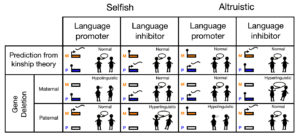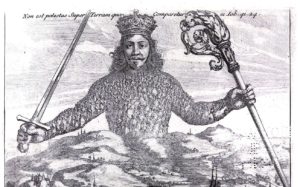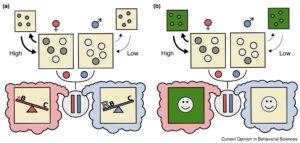Kerstin Stucky has begun her PhD with us this week; she’ll be working on social and cultural evolution in humans. Welcome to the lab, Kerstin!
[New Paper] Genomic imprinting as a window into human language evolution
Hitchcock TJ, Paracchini S & Gardner A (2019) Genomic imprinting as a window into human language evolution. BioEssays 41, 1800212.
Humans spend large portions of their time and energy talking to one another, yet it remains unclear whether this activity is primarily selfish or altruistic. Here, it is shown how parent‐of‐origin specific gene expression—or “genomic imprinting”—may provide an answer to this question. First, it is shown why, regarding language, only altruistic or selfish scenarios are expected. Second, it is pointed out that an individual’s maternal‐origin and paternal‐origin genes may have different evolutionary interests regarding investment into language, and that this intragenomic conflict may drive genomic imprinting which—as the direction of imprint depends upon whether investment into language is relatively selfish or altruistic—may be used to discriminate between these two possibilities. Third, predictions concerning the impact of various mutations and epimutations at imprinted loci on language pathologies are derived. In doing so, a framework is developed that highlights avenues for using intragenomic conflicts to investigate the evolutionary drivers of language.
[New Paper] Sexual selection in complex communities: Integrating interspecific reproductive interference in structured populations
McDonald GC, Gardner A & Pizzari T (in press) Sexual selection in complex communities: integrating interspecific reproductive interference in structured populations. Evolution.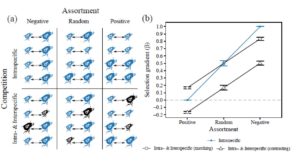
The social structure of populations plays a key role in shaping variation in sexual selection. In nature, sexual selection occurs in communities of interacting species; however, heterospecifics are rarely included in characterizations of social structure. Heterospecifics can influence the reproductive outcomes of intrasexual competition by interfering with intraspecific sexual interactions (interspecific reproductive interference [IRI]). We outline the need for studies of sexual selection to incorporate heterospecifics as part of the social environment. We use simulations to show that classic predictions for the effect of social structure on sexual selection are altered by an interaction between social structure and IRI. This interaction has wide‐ranging implications for patterns of sexual conflict and kin‐selected reproductive strategies in socially structured populations. Our work bridges the gap between sexual selection research on social structure and IRI, and highlights future directions to study sexual selection in interacting communities.
[New Paper] How to make a haploid male
Ross L, Davies NG & Gardner A (in press) How to make a haploid male. Evolution Letters.
Haplodiploidy has evolved repeatedly among invertebrates, and appears to be associated with inbreeding. Evolutionary biologists have long debated the possible benefits for females in diplodiploid species to produce haploid sons–beginning their population’s transition to haplodiploidy–and whether inbreeding promotes or inhibits this transition. However, little attention has been given to what makes a haploid individual male rather than female, and whether the mechanism of sex determination may modulate the costs and benefits of male haploidy. We remedy this by performing a theoretical analysis of the origin and invasion of male haploidy across the full range of sex‐determination mechanisms and sib‐mating rates. We find that male haploidy is facilitated by three different mechanisms of sex determination–all involving male heterogamety–and impeded by the others. We also find that inbreeding does not pose an obvious evolutionary barrier, on account of a previously neglected sex‐ratio effect whereby the production of haploid sons leads to an abundance of granddaughters that is advantageous in the context of inbreeding. We find empirical support for these predictions in a survey of sex determination and inbreeding across haplodiploids and their sister taxa.
[Job Opportunity] Three 4-year Research Fellowship positions in social evolution theory
I am advertising three 4-year Research Fellow positions in the area of social evolution theory (details here). The project is very flexible and will be tailored to the skills, experience and interests of the assembled team. The application deadline is 28 Feb 2019.
[New Paper] The social evolution of sleep
Faria GS, Varela SAM & Gardner A (2019) The social evolution of sleep: sex differences, intragenomic conflicts and clinical pathologies. Proceedings of the Royal Society of London Series B — Biological Sciences 286, 20182188.

Sleep appears to be essential for most animals, including humans. Accordingly, individuals who sacrifice sleep are expected to incur costs and so should only be evolutionarily favoured to do this when these costs are offset by other benefits. For instance, a social group might benefit from having some level of wakefulness during the sleeping period if this guards against possible threats. Alternatively, individuals might sacrifice sleep in order to gain an advantage over mate competitors. Here, we perform a theoretical analysis of the social evolutionary pressures that drive investment into sleep versus wakefulness. Specifically, we: investigate how relatedness between social partners may modulate sleeping strategies, depending upon whether sleep sacrifice is selfish or altruistic; determine the conditions under which the sexes are favoured to adopt different sleeping strategies; identify the potential for intragenomic conflict between maternal-origin versus paternal-origin genes regarding an individual’s sleeping behaviour; translate this conflict into novel and readily testable predictions concerning patterns of gene expression; and explore the concomitant effects of different kinds of mutations, epimutations, and uniparental disomies in relation to sleep disorders and other clinical pathologies. Our aim is to provide a theoretical framework for future empirical data and stimulate further research on this neglected topic.
[New Paper] Inclusive fitness for in-laws
Dyble M, Gardner A, Vinicius L & Migliano AB (2018) Inclusive fitness for in-laws. Biology Letters 14, 20180515.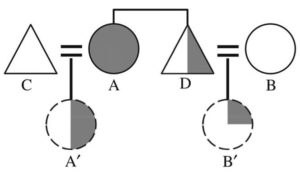 Cooperation among kin is common across the natural world and can be explained in terms of inclusive fitness theory, which holds that individuals can derive indirect fitness benefits from aiding genetically related individuals. However, human kinship includes not only genetic kin but also kin by marriage: our affines (in-laws) and spouses. Can cooperation between these genetically unrelated kin be reconciled with inclusive fitness theory? Here, we argue that although affinal kin and spouses do not necessarily share genetic ancestry, they may have shared genetic interests in future reproduction and, as such, can derive indirect fitness benefits though cooperating. We use standard inclusive fitness theory to derive a coefficient of shared reproductive interest (s) that predicts altruistic investment both in genetic kin and in spouses and affines. Specifically, a behaviour that reduces the fitness of the actor by c and increases the fitness of the recipient by b will be favoured by natural selection when sb > c. We suggest that the coefficient of shared reproductive interest may provide a valuable tool for understanding not only the evolution of human kinship but also cooperation and conflict across the natural world more generally.
Cooperation among kin is common across the natural world and can be explained in terms of inclusive fitness theory, which holds that individuals can derive indirect fitness benefits from aiding genetically related individuals. However, human kinship includes not only genetic kin but also kin by marriage: our affines (in-laws) and spouses. Can cooperation between these genetically unrelated kin be reconciled with inclusive fitness theory? Here, we argue that although affinal kin and spouses do not necessarily share genetic ancestry, they may have shared genetic interests in future reproduction and, as such, can derive indirect fitness benefits though cooperating. We use standard inclusive fitness theory to derive a coefficient of shared reproductive interest (s) that predicts altruistic investment both in genetic kin and in spouses and affines. Specifically, a behaviour that reduces the fitness of the actor by c and increases the fitness of the recipient by b will be favoured by natural selection when sb > c. We suggest that the coefficient of shared reproductive interest may provide a valuable tool for understanding not only the evolution of human kinship but also cooperation and conflict across the natural world more generally.
[PhD Opportunity] Theory of social evolution
I am offering a fully-funded, 3.5 year PhD studentship on “Theory of social evolution” (details here). The application deadline is 2 Dec 2018.
[New Paper] Why war is a man’s game
Micheletti AJC, Ruxton GD & Gardner A (2018) Why war is a man’s game. Proceedings of the Royal Society of London Series B — Biological Sciences 285, 20180975.
Interest in the evolutionary origins and drivers of warfare in ancient and contemporary small-scale human societies has greatly increased in the last decade, and has been particularly spurred by exciting archaeological discoveries that suggest our ancestors led more violent lives than previously documented. However, the striking observation that warfare is an almost-exclusively male activity remains unexplained. Three general hypotheses have been proposed, concerning greater male effectiveness in warfare, lower male costs, and patrilocality. But while each of these factors might explain why warfare is more common in men, they do not convincingly explain why women almost never participate. Here, we develop a mathematical model to formally assess these hypotheses. Surprisingly, we find that exclusively male warfare may evolve even in the absence of any such sex differences, though sex biases in these parameters can make this evolutionary outcome more likely. The qualitative observation that participation in warfare is almost exclusive to one sex is ultimately explained by the fundamentally sex-specific nature of Darwinian competition—in fitness terms, men compete with men and women with women. These results reveal a potentially key role for ancestral conditions in shaping our species’ patterns of sexual division of labour and violence-related adaptations and behavioural disorders.
[New Paper] Parent-of-origin specific gene expression and dispersal
Hitchcock TJ & Gardner A (2019) Parent-of-origin specific gene expression and dispersal. Current Opinion in Behavioral Sciences 25, 36-43.
Genes can behave in ways that are conditional upon their parent-of-origin. The best understood form of this is genomic imprinting (GI), which typically involves the silencing of a gene originating from one parent and the expression of its homologue originating from the other parent. A number of hypotheses have been proposed to explain GI, which may be grouped into those based on asymmetries of genetic interest versus those based on asymmetries of genetic information. Dispersal patterns can drive both of these asymmetries and modulate the costs and benefits of imprinting. GI may also have consequences for dispersal of individuals and genes, by driving imprinting of loci underpinning dispersal, altering the fitness consequences of dispersal, and affecting rates of introgression.
